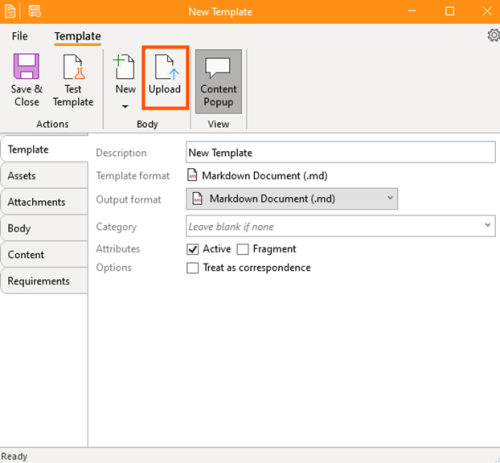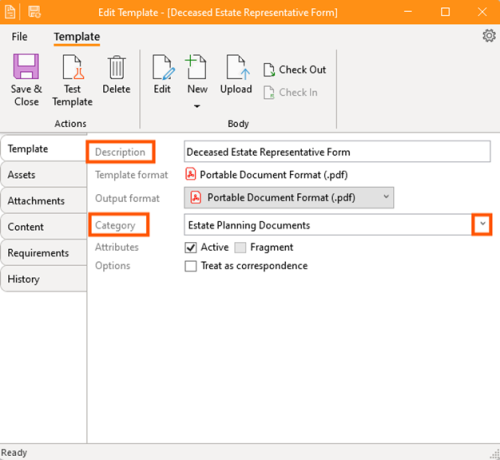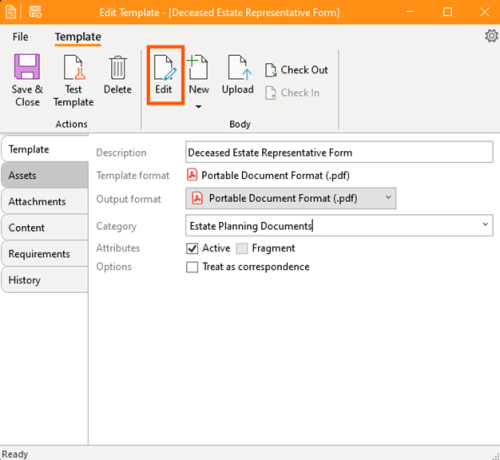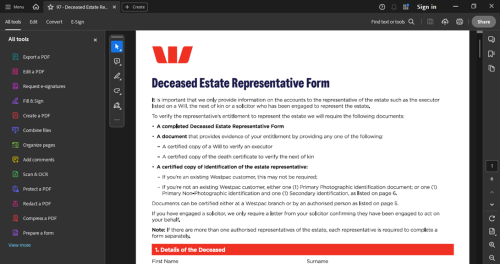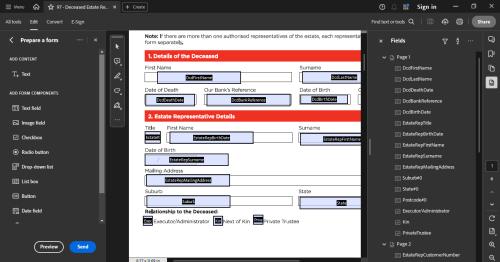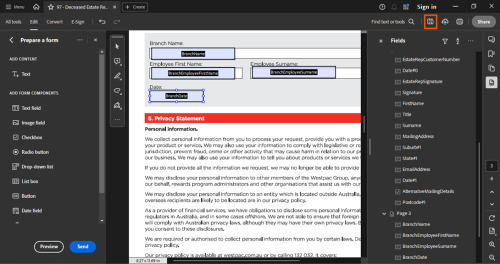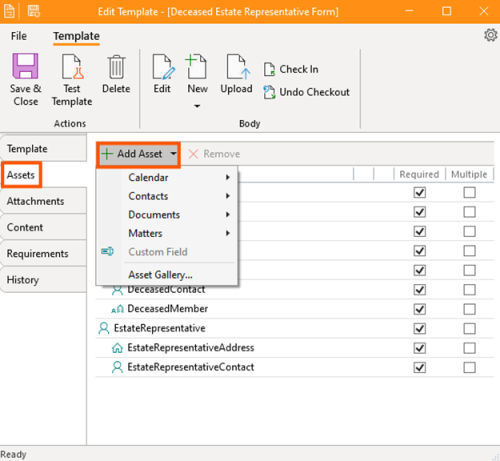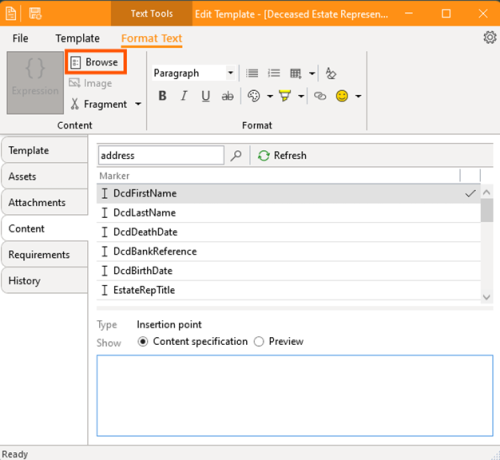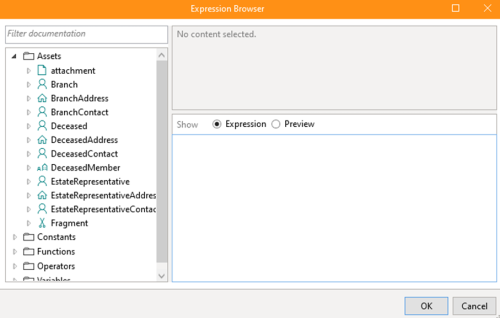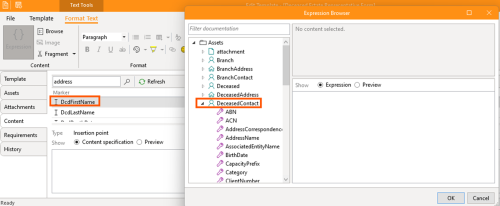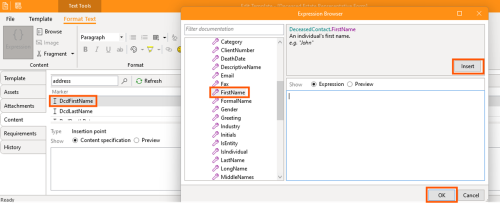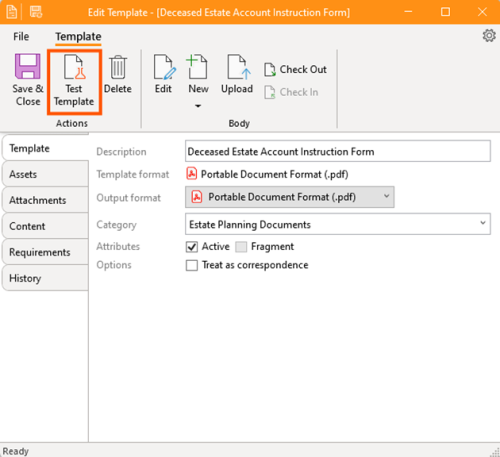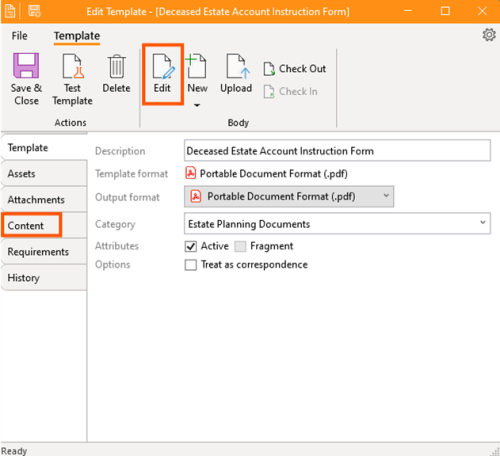How-To:PDF Template: Difference between revisions
No edit summary |
No edit summary |
||
| Line 1: | Line 1: | ||
[[ContactsLaw]] provides a comprehensive document creation system. Its templating functions allow the creation and sharing of powerful templates to reduce data entry and streamline document creation. Users can build and configure their own templates within the system. | |||
For a general overview of creating a template, review the | For a general overview of creating a template, review the [[How-To:Create Template|Create Template]] guide. | ||
== 1. Getting Started == | |||
* Open the New Template window (see the [[How-To:Create Template|Create Template]] guide). | |||
* Click “Upload” and choose the PDF file you want to use as a template.[[File:Step 3 - PDF Template.png|none|thumb|500x500px]] | |||
== 2. Specify Options == | |||
* After uploading the PDF, name the template (by changing the description). If you wish to group the template by a category, enter or select a category name.[[File:Step 4 - PDF Template.png|none|thumb|500x500px]] | |||
* Navigate to the Content menu and click refresh. If your PDF file was sourced from a third party and has editable fields, you will likely find numerous meaningless content names appear. This is because the third party has not named the various form fields.[[File:Step 8 - PDF Template.png|none|thumb|500x500px]] | |||
* To have the best templating experience we need to give the fields within the PDF template meaningful names. Start by clicking Edit to open the PDF file.[[File:Step 5 - PDF Template.png|none|thumb|500x500px]] | |||
== 3. Prepare PDF Form Content == | |||
* We recommend using Adobe Acrobat to edit the PDF file. Within Adobe Acrobat, open the field editor or use the "Prepare a Form" function to generate fields. You should give the fields meaningful names as these will be the names that appear in the content section of the [[ContactsLaw]] template editor. | |||
[[File:Step 6.1 - PDF Template.png|none|thumb|500x500px|[[File:Step 6.2 - PDF Template.png|none|thumb|500x500px]]]] | |||
* Once you have finished generating and naming the fields in Adobe Acrobat, save the document and click "Check In" in the ContactsLaw "Edit Template" window. [[File:Step 7 - PDF Template.png|none|thumb|500x500px]] | |||
* Click the "'''Refresh"''' button in the "Content" window. Your newly generated/named fields will then appear. | |||
== 4. Specify Assets == | |||
* Next proceed to the “Assets” and add the assets that you are going to draw upon to populate the Content fields.[[File:Step 9 - PDF Template.png|none|thumb|500x500px]] | |||
*Proceed to map the content fields in the document (referring to the Assets selected). The easiest way to do this is to click the “'''Browse'''” which will then give you the list of assets and different attributes that can be drawn on.[[File:Step 10 - PDF Template.png|none|thumb|500x500px|[[File:Step 10.1 - PDF Template.png|none|thumb|500x500px]]]] | |||
*Select the asset/attributes for each content field. You can also apply formatting. See [[Document Template]] for an explanation as to content fields and formatting). [[File:Step 11 - PDF Template.png|none|thumb|500x500px|[[File:Step 11.1 - PDF Template.png|none|thumb|500x500px]]]] | |||
== 5. Final Steps == | |||
* You can test your template at any time by clicking "Test Template" which will use generic information to populate your template fields.[[File:Step 14 - PDF Template.png|none|thumb|500x500px]] | |||
*To correct any faults or issues with the template, you can return to the "Content" menu to alter the mappings. [[File:Step 15 - PDF Template.png|none|thumb|500x500px]] | |||
*The template will then need to be '''[[Configuring a Template|Configured]]'''. | |||
Revision as of 08:20, 10 October 2024
ContactsLaw provides a comprehensive document creation system. Its templating functions allow the creation and sharing of powerful templates to reduce data entry and streamline document creation. Users can build and configure their own templates within the system.
For a general overview of creating a template, review the Create Template guide.
1. Getting Started
- Open the New Template window (see the Create Template guide).
- Click “Upload” and choose the PDF file you want to use as a template.
2. Specify Options
- After uploading the PDF, name the template (by changing the description). If you wish to group the template by a category, enter or select a category name.
- Navigate to the Content menu and click refresh. If your PDF file was sourced from a third party and has editable fields, you will likely find numerous meaningless content names appear. This is because the third party has not named the various form fields.
- To have the best templating experience we need to give the fields within the PDF template meaningful names. Start by clicking Edit to open the PDF file.
3. Prepare PDF Form Content
- We recommend using Adobe Acrobat to edit the PDF file. Within Adobe Acrobat, open the field editor or use the "Prepare a Form" function to generate fields. You should give the fields meaningful names as these will be the names that appear in the content section of the ContactsLaw template editor.
- Once you have finished generating and naming the fields in Adobe Acrobat, save the document and click "Check In" in the ContactsLaw "Edit Template" window.
- Click the "Refresh" button in the "Content" window. Your newly generated/named fields will then appear.
4. Specify Assets
- Next proceed to the “Assets” and add the assets that you are going to draw upon to populate the Content fields.
- Proceed to map the content fields in the document (referring to the Assets selected). The easiest way to do this is to click the “Browse” which will then give you the list of assets and different attributes that can be drawn on.
- Select the asset/attributes for each content field. You can also apply formatting. See Document Template for an explanation as to content fields and formatting).
5. Final Steps
- You can test your template at any time by clicking "Test Template" which will use generic information to populate your template fields.
- To correct any faults or issues with the template, you can return to the "Content" menu to alter the mappings.
- The template will then need to be Configured.


